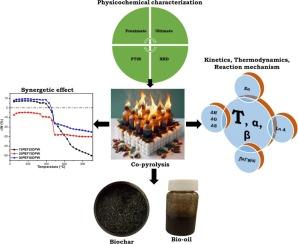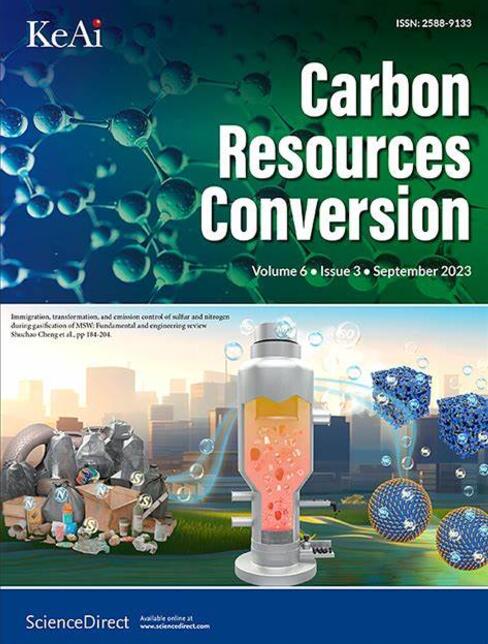Synergism, pyrolysis performance, product distribution and characteristics in the co-pyrolysis of date palm waste and polyethylene foam: Harnessing the potential of plastics and biomass valorization
IF 7.5
3区 环境科学与生态学
Q2 ENERGY & FUELS
引用次数: 0
Abstract
The current methods of disposing of plastic waste, such as dumping or burning, create significant ecological problems and cause irreparable damage to valuable resources. This is especially true for plastics with complex structures, like polyethylene foams (PEF). This study focuses on how the plastic composition affects the interactions, kinetics, thermodynamics, yield of pyrolysis products, and their characterization during the co-pyrolysis of date palm waste (DPW) and PEF. Co-pyrolysis experiments were conducted at three different heating rates (10, 20, and 30 °C/min) and with varying biomass ratios to plastic. The kinetic parameters were evaluated using different isoconversional techniques such as Kissinger Akahira Sunose (KAS), Vyazovkin (VZK), Ozawa Flynn Wall (OFW), and Friedman (FM). The average value of activation energy based on the Vyazovkin model is 96.31, 216.33, 232.85, 382.69, and 206.47 kJ/mol for DPW, PEF, 75PEF25DPW, 25PEF75DPW, and 50PEF50DPW, respectively. The thermodynamic results showed that the average difference between activation energy and enthalpy is 4.89, 6.02, 5.81, 5.36, and 5.61 kJ/mol for the DPW, PEF, 75PEF25DPW, 25PEF75DPW, and 50PEF50DPW, respectively. It is lowest for the DPW and highest for the PEF, whereas it is significantly lower for the mixes, indicating that the mixes consume less energy. Criado’s master plot suggested that the co-pyrolysis of DPW and PEF followed D1 (one-dimensional) and D3 (three-dimensional) reaction mechanisms. Further, co-pyrolysis results from the fixed bed reactor confirmed maximum bio-oil yield (38.85 wt%) was achieved at 50PEF50DPW ratio. The results of this study suggest that combining waste date palms with PEF could be a promising option for improving the co-pyrolysis process.

椰枣废料和聚乙烯泡沫共热解的协同作用、热解性能、产品分布和特性:利用塑料和生物质增值的潜力
目前处理塑料废物的方法,如倾倒或焚烧,造成了严重的生态问题,并对宝贵的资源造成了不可弥补的损害。对于结构复杂的塑料来说尤其如此,比如聚乙烯泡沫塑料(PEF)。研究了塑料组分对枣椰树废弃物和PEF共热解过程中相互作用、动力学、热力学、热解产物产率及其表征的影响。在三种不同的升温速率(10、20和30°C/min)和不同的生物质与塑料的比例下进行共热解实验。采用Kissinger Akahira Sunose (KAS)、Vyazovkin (VZK)、Ozawa Flynn Wall (OFW)和Friedman (FM)等转换技术对动力学参数进行了评价。基于Vyazovkin模型的DPW、PEF、75PEF25DPW、25PEF75DPW和50PEF50DPW的平均活化能分别为96.31、216.33、232.85、382.69和206.47 kJ/mol。热力学结果表明,DPW、PEF、75PEF25DPW、25PEF75DPW和50PEF50DPW的活化能和焓的平均差值分别为4.89、6.02、5.81、5.36和5.61 kJ/mol。DPW的能量最低,PEF的能量最高,而混合料的能量明显较低,表明混合料消耗的能量更少。Criado的主图表明,DPW和PEF共热解遵循D1(一维)和D3(三维)反应机制。此外,固定床反应器的共热解结果证实,在50PEF50DPW比下,生物油收率最高(38.85 wt%)。本研究结果表明,将废椰枣与PEF结合可能是改善共热解过程的一种有希望的选择。
本文章由计算机程序翻译,如有差异,请以英文原文为准。
求助全文
约1分钟内获得全文
求助全文
来源期刊

Carbon Resources Conversion
Materials Science-Materials Science (miscellaneous)
CiteScore
9.90
自引率
11.70%
发文量
36
审稿时长
10 weeks
期刊介绍:
Carbon Resources Conversion (CRC) publishes fundamental studies and industrial developments regarding relevant technologies aiming for the clean, efficient, value-added, and low-carbon utilization of carbon-containing resources as fuel for energy and as feedstock for materials or chemicals from, for example, fossil fuels, biomass, syngas, CO2, hydrocarbons, and organic wastes via physical, thermal, chemical, biological, and other technical methods. CRC also publishes scientific and engineering studies on resource characterization and pretreatment, carbon material innovation and production, clean technologies related to carbon resource conversion and utilization, and various process-supporting technologies, including on-line or off-line measurement and monitoring, modeling, simulations focused on safe and efficient process operation and control, and process and equipment optimization.
 求助内容:
求助内容: 应助结果提醒方式:
应助结果提醒方式:


